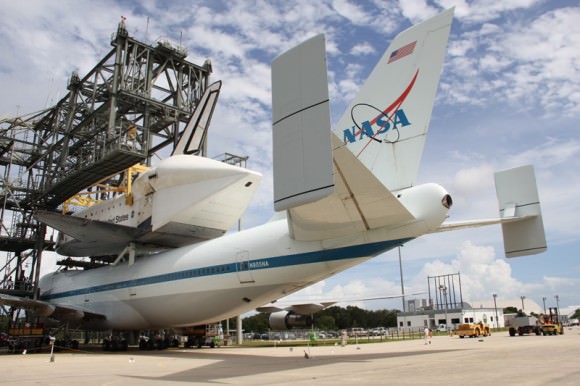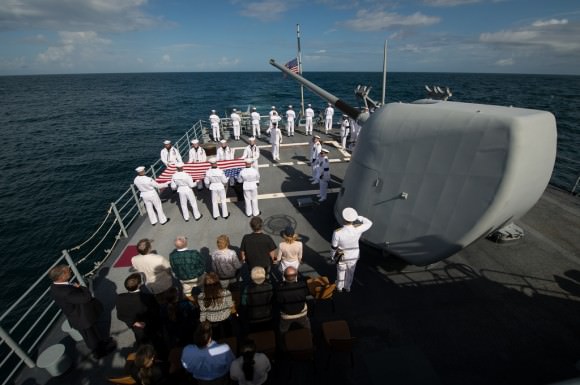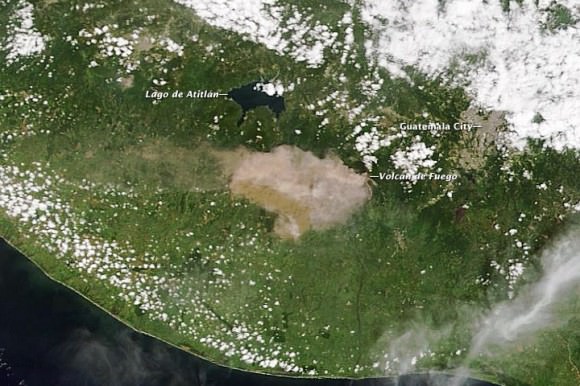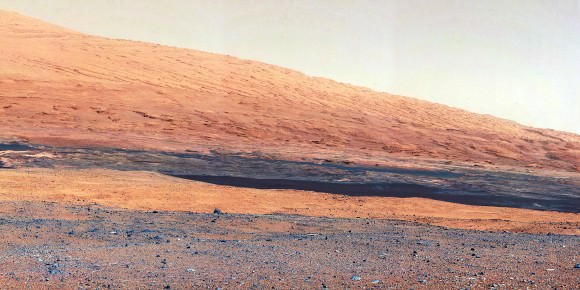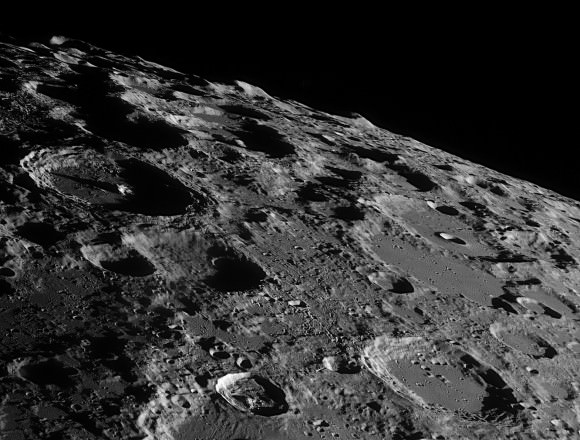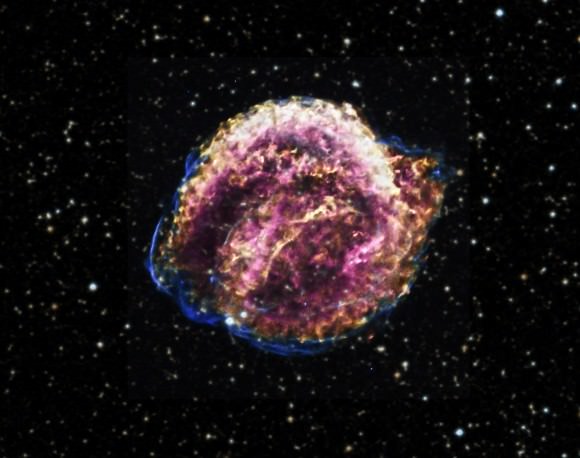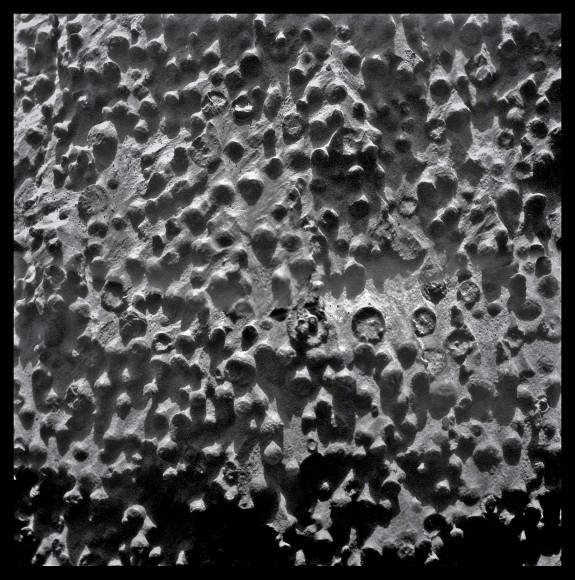Welcome home to Gennady Padalka, Joe Acaba and Sergei Revin! The trio landed safely in Kazakhstan at 02:54 UTC on Monday, September 17 (8:53 a.m. Kazakhstan time Monday, 10:53 p.m. EDT Sunday, September 16). Expedition 32 officially ended when Soyuz TMA-04M the trio undocked at 23:09 UTC Sunday from the Poisk module. The had been on the International Space Station since May 17, spending a total of 123 days on the orbital laboratory.

The Soyuz TMA-04M spacecraft is seen as it lands with the Expedition 32 crew. Credit: NASA/Carla Cioffi
{
 Globular Cluster M15 from Hubble – Credit: ESA, Hubble, NASA
Greetings, fellow SkyWatchers! This looks like a great week to take in some galactic star clusters and enjoy the Andromeda Galaxy! Some lucky viewers are in for a Mars occultation event and everyone wins with a meteor shower. What’s that, you say? Darn right. This week is also the time of the Autumnal Equinox! When ever you’re ready to learn more, just meet me in the back yard… [click to continue…]
Globular Cluster M15 from Hubble – Credit: ESA, Hubble, NASA
Greetings, fellow SkyWatchers! This looks like a great week to take in some galactic star clusters and enjoy the Andromeda Galaxy! Some lucky viewers are in for a Mars occultation event and everyone wins with a meteor shower. What’s that, you say? Darn right. This week is also the time of the Autumnal Equinox! When ever you’re ready to learn more, just meet me in the back yard… [click to continue…]
Read more: http://www.universetoday.com/#ixzz26ieBQQMl
Shuttle Endeavour mated to Jumbo Jet for Final Flight
Space Shuttle Endeavour was joined to the 747 Jumbo carrier jet that will carry her majestically on Sept 17 on her final flight to the California Science Center – her permanent new home at the in Los Angeles. Enjoy my photos from onsite at the Kennedy Space Center in Florida.
On Friday (Sept. 14), Endeavour was towed a few miles in the predawn darkness from the Vehicle Assembly Building (VAB ) to the Shuttle Landing Facility (SLF) and the specially modified 747 known as the Shuttle Carrier Aircraft, or SCA. [click to continue…]
Read more: http://www.universetoday.com/#ixzz26icnniIZ
Armstrong’s burial service aboard the USS Philippine Sea on September 14, 2012 (NASA/Bill Ingalls)
Earlier today, Friday, September 14, 2012, Neil A. Armstrong’s burial at sea service was held aboard the USS Philippine Sea (CG 58) in the Atlantic Ocean. Armstrong, the first man to walk on the moon during the 1969 Apollo 11 mission, died Saturday, August 25. He was 82.
An icon of exploration for all of humanity, he will be missed by millions and remembered forever. Godspeed, sir, and thank you.
See more photos below.
Read more: http://www.universetoday.com/#ixzz26iQYURpO
Satellite View of Guatemalan Volcano Eruptingby sandeep janjirala on SEPTEMBER 14, 2012
A natural-color image captured the eruption of Volcan de Fuego as it occurred. Credit: NASA/Moderate Resolution Imaging Spectroradiometer (MODIS) aboard the Terra satellite.
One of Central American’s most active volcanos erupted on September 13th, 2012 prompting officials to evacuate 35,000 residents in Guatemala. The Volcan de Fuego, or Fire Volcano, began belching out ash at 10 a.m. local time with ash now falling up to 40 kilometers (25 miles) from the volcano. Residents within 20 kilometers (12 miles) of the volcano were being removed from the area in buses and cars.
[click to continue…]
Read more: http://www.universetoday.com/#ixzz26iPa2TSi
Neil Armstrong, the first person to set foot on the Moon, was honored in a memorial service at the Washington National Cathedral on September 13, 2012. He was remembered as a quiet but strong hero who led mankind into space. Armstrong died last month at 82 following complications after heart surgery. He will be buried at sea in the Naval tradition today (Friday, September 14, 2012) at an undisclosed site.
Read more: http://www.universetoday.com/#ixzz26iNRkN3w
“He embodied all that is good and all that is great about America. Neil, wherever you are, you again have shown us a way to the stars,” said Gene Cernan during the memorial. Cernan was commander of the Apollo 17 mission in 1972 and the last person to walk on the Moon.
If you missed watching it live, here is a video of the entire service. The National Cathedral was a fitting place to remember Armstrong, as it has one stained glass window, known as the Space Window, which has a piece of Moon rock presented by Armstrong and his Apollo 11 crewmates Buzz Aldrin and Michael Collins in 1974.
[click to continue…]
Read more: http://www.universetoday.com/#ixzz26iNFBSgO
Sonic-Powered Levitation Allows Zero-G Drug Research
by sandeep janjirala on SEPTEMBER 14, 2012
It’s not special effects: researchers at the U.S. Department of Energy’s Argonne National Laboratory in Illinois have developed a way to cancel out the effects of gravity, allowing liquids to be held without containers. The effect is created using sound waves emitted by an acoustic levitator — an instrument designed by NASA for simulating microgravity.Watch the video. It’s the coolest ing you’ll see all week.
Read more: http://www.universetoday.com/#ixzz26iMDfu7I
In Fact It’s Cold As Hell: Mars Isn’t As Earthlike As It Might Look
Read more: http://www.universetoday.com/#ixzz26SIqhkTX
The slopes of Gale Crater as seen by Curiosity are reminiscent of the American southwest (NASA/JPL-Caltech)
Read more: http://www.universetoday.com/#ixzz26SIa0h3D
“Mars ain’t no kind of place to raise your kids; in fact it’s cold as hell” sang Elton John in “Rocket Man”, and although the song was released in 1972 — four years before the first successful landing on Mars — his weather forecast was spot-on. Even though the fantastic images that are being returned from NASA’s Curiosity rover show a rocky, ruddy landscape that could easily be mistaken for an arid region of the American Southwest one must remember three things: this is Mars, we’re looking around the inside of an impact crater billions of years old, and it’s cold out there.
The Weekly Space Hangout is back from Summer hiatus, with a mountain of space news. This week we tackle:
- Dawn Completes Science Mapping at Vesta
- Amateurs Spot an Explosion on Jupiter
- Curiosity Takes a Few Self Portraits
- Endeavour Prepares to Move to Los Angeles
Host: Fraser Cain
We record the Weekly Space Hangout every Thursday at 10 am Pacific / 1 pm Eastern. Watch us live on Google+, ask your questions to the gathered space journalists.
Take a deep breath because this new panorama from Mars enthusiast Stu Atkinson will take it away.
Read more: http://www.universetoday.com/#ixzz26SHh02aw
“Anyway, a whole bunch of these came down, like I said, and to my delight they all linked up to form a big, biiiiiiiig panoramic mosaic,” said Stu on his blog “The Gale Gazette.” “And here it is. Obviously you’ll need to click on it to enlarge it… and I’ll warn you, it’s a big image, you can kiss the next few minutes goodbye because you’ll be panning around it for a while…”
Zoom in and you can see actual rocks. Click that little button at the right of the toolbar and Mars will take over your screen.
A newly found asteroid will zip past Earth tonight (Sept. 13/14). But don’t worry; at a distance of 2.85 million km (1.7 million miles) Asteroid 2012 QG42 will safely pass by Earth. But that’s close enough for this space rock to be considered a Potentially Hazardous Asteroid (PHA) which means it may pose a threat in the future. This asteroid is between 190 to 430 meters (625 feet to 1,400 feet) wide and was first spotted by astronomers at the Catalina Sky Survey in Arizona on August 26. NASA’s Near Earth Object Office said they will use this opportunity to observe the asteroid with radar – which is a great way to find out about the physical properties and orbits of asteroids.
Read more: http://www.universetoday.com/#ixzz26SGqbBKS
Amateur and professional astronomers have already been keeping tabs on this asteroid. Above is a timelapse from Peter Lake. And a couple of different live feeds from telescopes will be available to watch the action.
[click to continue…]
The Morteus region on the Moon, taken from the suburbs of Paris, France. Credit: Thierry Legault. Used by permission.
Think this is an orbital view of the Moon? Guess again. Astrophotographer Thierry Legault took this image from his backyard in the suburbs of Paris, France! He’s taken a series of images of the Moon the past few nights that will blow your mind when you consider they were taken from Earth, within the confines of the metropolis of Paris (largest city in France, 5th largest in the EU, 20th largest in the world). Thierry used a Celestron C14 EdgeHD (356mm) and Skynyx2.2 camera. You definitely want to click on these images for the larger versions on Thierry’s website, and he suggests using a full-HD screen in subdued surroundings.
Additionally, Thierry also recently took images of Mercury and Uranus that include incredible detail.
[click to continue…]
A composite image of Chandra X-ray data shows a rainbow of reds, yellows, green, blue and purple, from lower to higher energies. Optical data from the Digitized Sky Survey, shown in pale yellow and blue, offer a starry background for the image. Optical: DSS
An arc of hot gas that spewed from the Kepler Supernova offers tantalizing clues that the cataclysmic stellar explosion of 1604 was not only more powerful than previously thought but also farther away according to a recent study using Chandra X-ray Observatory data published in the September 1, 2012 edition of The Astrophysical Journal.
[click to continue…]
Read more: http://www.universetoday.com/#ixzz26SF5Xg5R
Welcome home to Gennady Padalka, Joe Acaba and Sergei Revin! The trio landed safely in Kazakhstan at 02:54 UTC on Monday, September 17 (8:53 a.m. Kazakhstan time Monday, 10:53 p.m. EDT Sunday, September 16). Expedition 32 officially ended when Soyuz TMA-04M the trio undocked at 23:09 UTC Sunday from the Poisk module. The had been on the International Space Station since May 17, spending a total of 123 days on the orbital laboratory.

The Soyuz TMA-04M spacecraft is seen as it lands with the Expedition 32 crew. Credit: NASA/Carla Cioffi
{
 Globular Cluster M15 from Hubble – Credit: ESA, Hubble, NASA
Greetings, fellow SkyWatchers! This looks like a great week to take in some galactic star clusters and enjoy the Andromeda Galaxy! Some lucky viewers are in for a Mars occultation event and everyone wins with a meteor shower. What’s that, you say? Darn right. This week is also the time of the Autumnal Equinox! When ever you’re ready to learn more, just meet me in the back yard… [click to continue…]
Globular Cluster M15 from Hubble – Credit: ESA, Hubble, NASA
Greetings, fellow SkyWatchers! This looks like a great week to take in some galactic star clusters and enjoy the Andromeda Galaxy! Some lucky viewers are in for a Mars occultation event and everyone wins with a meteor shower. What’s that, you say? Darn right. This week is also the time of the Autumnal Equinox! When ever you’re ready to learn more, just meet me in the back yard… [click to continue…]
Read more: http://www.universetoday.com/#ixzz26ieBQQMl
Shuttle Endeavour mated to Jumbo Jet for Final Flight
Space Shuttle Endeavour was joined to the 747 Jumbo carrier jet that will carry her majestically on Sept 17 on her final flight to the California Science Center – her permanent new home at the in Los Angeles. Enjoy my photos from onsite at the Kennedy Space Center in Florida.
On Friday (Sept. 14), Endeavour was towed a few miles in the predawn darkness from the Vehicle Assembly Building (VAB ) to the Shuttle Landing Facility (SLF) and the specially modified 747 known as the Shuttle Carrier Aircraft, or SCA. [click to continue…]
Read more: http://www.universetoday.com/#ixzz26icnniIZ
Armstrong’s burial service aboard the USS Philippine Sea on September 14, 2012 (NASA/Bill Ingalls)
Earlier today, Friday, September 14, 2012, Neil A. Armstrong’s burial at sea service was held aboard the USS Philippine Sea (CG 58) in the Atlantic Ocean. Armstrong, the first man to walk on the moon during the 1969 Apollo 11 mission, died Saturday, August 25. He was 82.
An icon of exploration for all of humanity, he will be missed by millions and remembered forever. Godspeed, sir, and thank you.
See more photos below.
Read more: http://www.universetoday.com/#ixzz26iQYURpO
Satellite View of Guatemalan Volcano Eruptingby sandeep janjirala on SEPTEMBER 14, 2012
A natural-color image captured the eruption of Volcan de Fuego as it occurred. Credit: NASA/Moderate Resolution Imaging Spectroradiometer (MODIS) aboard the Terra satellite.
One of Central American’s most active volcanos erupted on September 13th, 2012 prompting officials to evacuate 35,000 residents in Guatemala. The Volcan de Fuego, or Fire Volcano, began belching out ash at 10 a.m. local time with ash now falling up to 40 kilometers (25 miles) from the volcano. Residents within 20 kilometers (12 miles) of the volcano were being removed from the area in buses and cars.
[click to continue…]
Read more: http://www.universetoday.com/#ixzz26iPa2TSi
Neil Armstrong, the first person to set foot on the Moon, was honored in a memorial service at the Washington National Cathedral on September 13, 2012. He was remembered as a quiet but strong hero who led mankind into space. Armstrong died last month at 82 following complications after heart surgery. He will be buried at sea in the Naval tradition today (Friday, September 14, 2012) at an undisclosed site.
Read more: http://www.universetoday.com/#ixzz26iNRkN3w
“He embodied all that is good and all that is great about America. Neil, wherever you are, you again have shown us a way to the stars,” said Gene Cernan during the memorial. Cernan was commander of the Apollo 17 mission in 1972 and the last person to walk on the Moon.
If you missed watching it live, here is a video of the entire service. The National Cathedral was a fitting place to remember Armstrong, as it has one stained glass window, known as the Space Window, which has a piece of Moon rock presented by Armstrong and his Apollo 11 crewmates Buzz Aldrin and Michael Collins in 1974.
[click to continue…]
Read more: http://www.universetoday.com/#ixzz26iNFBSgO
Sonic-Powered Levitation Allows Zero-G Drug Research
by sandeep janjirala on SEPTEMBER 14, 2012
It’s not special effects: researchers at the U.S. Department of Energy’s Argonne National Laboratory in Illinois have developed a way to cancel out the effects of gravity, allowing liquids to be held without containers. The effect is created using sound waves emitted by an acoustic levitator — an instrument designed by NASA for simulating microgravity.Watch the video. It’s the coolest ing you’ll see all week.
Read more: http://www.universetoday.com/#ixzz26iMDfu7I
Welcome home to Gennady Padalka, Joe Acaba and Sergei Revin! The trio landed safely in Kazakhstan at 02:54 UTC on Monday, September 17 (8:53 a.m. Kazakhstan time Monday, 10:53 p.m. EDT Sunday, September 16). Expedition 32 officially ended when Soyuz TMA-04M the trio undocked at 23:09 UTC Sunday from the Poisk module. The had been on the International Space Station since May 17, spending a total of 123 days on the orbital laboratory.

The Soyuz TMA-04M spacecraft is seen as it lands with the Expedition 32 crew. Credit: NASA/Carla Cioffi
{
 Globular Cluster M15 from Hubble – Credit: ESA, Hubble, NASA
Greetings, fellow SkyWatchers! This looks like a great week to take in some galactic star clusters and enjoy the Andromeda Galaxy! Some lucky viewers are in for a Mars occultation event and everyone wins with a meteor shower. What’s that, you say? Darn right. This week is also the time of the Autumnal Equinox! When ever you’re ready to learn more, just meet me in the back yard… [click to continue…]
Globular Cluster M15 from Hubble – Credit: ESA, Hubble, NASA
Greetings, fellow SkyWatchers! This looks like a great week to take in some galactic star clusters and enjoy the Andromeda Galaxy! Some lucky viewers are in for a Mars occultation event and everyone wins with a meteor shower. What’s that, you say? Darn right. This week is also the time of the Autumnal Equinox! When ever you’re ready to learn more, just meet me in the back yard… [click to continue…]
Read more: http://www.universetoday.com/#ixzz26ieBQQMl
Shuttle Endeavour mated to Jumbo Jet for Final Flight
Space Shuttle Endeavour was joined to the 747 Jumbo carrier jet that will carry her majestically on Sept 17 on her final flight to the California Science Center – her permanent new home at the in Los Angeles. Enjoy my photos from onsite at the Kennedy Space Center in Florida.
On Friday (Sept. 14), Endeavour was towed a few miles in the predawn darkness from the Vehicle Assembly Building (VAB ) to the Shuttle Landing Facility (SLF) and the specially modified 747 known as the Shuttle Carrier Aircraft, or SCA. [click to continue…]
Read more: http://www.universetoday.com/#ixzz26icnniIZ
Armstrong’s burial service aboard the USS Philippine Sea on September 14, 2012 (NASA/Bill Ingalls)
Earlier today, Friday, September 14, 2012, Neil A. Armstrong’s burial at sea service was held aboard the USS Philippine Sea (CG 58) in the Atlantic Ocean. Armstrong, the first man to walk on the moon during the 1969 Apollo 11 mission, died Saturday, August 25. He was 82.
An icon of exploration for all of humanity, he will be missed by millions and remembered forever. Godspeed, sir, and thank you.
See more photos below.
Read more: http://www.universetoday.com/#ixzz26iQYURpO
Satellite View of Guatemalan Volcano Eruptingby sandeep janjirala on SEPTEMBER 14, 2012
A natural-color image captured the eruption of Volcan de Fuego as it occurred. Credit: NASA/Moderate Resolution Imaging Spectroradiometer (MODIS) aboard the Terra satellite.
One of Central American’s most active volcanos erupted on September 13th, 2012 prompting officials to evacuate 35,000 residents in Guatemala. The Volcan de Fuego, or Fire Volcano, began belching out ash at 10 a.m. local time with ash now falling up to 40 kilometers (25 miles) from the volcano. Residents within 20 kilometers (12 miles) of the volcano were being removed from the area in buses and cars.
[click to continue…]
Read more: http://www.universetoday.com/#ixzz26iPa2TSi
Neil Armstrong, the first person to set foot on the Moon, was honored in a memorial service at the Washington National Cathedral on September 13, 2012. He was remembered as a quiet but strong hero who led mankind into space. Armstrong died last month at 82 following complications after heart surgery. He will be buried at sea in the Naval tradition today (Friday, September 14, 2012) at an undisclosed site.
Read more: http://www.universetoday.com/#ixzz26iNRkN3w
“He embodied all that is good and all that is great about America. Neil, wherever you are, you again have shown us a way to the stars,” said Gene Cernan during the memorial. Cernan was commander of the Apollo 17 mission in 1972 and the last person to walk on the Moon.
If you missed watching it live, here is a video of the entire service. The National Cathedral was a fitting place to remember Armstrong, as it has one stained glass window, known as the Space Window, which has a piece of Moon rock presented by Armstrong and his Apollo 11 crewmates Buzz Aldrin and Michael Collins in 1974.
[click to continue…]
Read more: http://www.universetoday.com/#ixzz26iNFBSgO
Welcome home to Gennady Padalka, Joe Acaba and Sergei Revin! The trio landed safely in Kazakhstan at 02:54 UTC on Monday, September 17 (8:53 a.m. Kazakhstan time Monday, 10:53 p.m. EDT Sunday, September 16). Expedition 32 officially ended when Soyuz TMA-04M the trio undocked at 23:09 UTC Sunday from the Poisk module. The had been on the International Space Station since May 17, spending a total of 123 days on the orbital laboratory.

The Soyuz TMA-04M spacecraft is seen as it lands with the Expedition 32 crew. Credit: NASA/Carla Cioffi
{
 Globular Cluster M15 from Hubble – Credit: ESA, Hubble, NASA
Greetings, fellow SkyWatchers! This looks like a great week to take in some galactic star clusters and enjoy the Andromeda Galaxy! Some lucky viewers are in for a Mars occultation event and everyone wins with a meteor shower. What’s that, you say? Darn right. This week is also the time of the Autumnal Equinox! When ever you’re ready to learn more, just meet me in the back yard… [click to continue…]
Globular Cluster M15 from Hubble – Credit: ESA, Hubble, NASA
Greetings, fellow SkyWatchers! This looks like a great week to take in some galactic star clusters and enjoy the Andromeda Galaxy! Some lucky viewers are in for a Mars occultation event and everyone wins with a meteor shower. What’s that, you say? Darn right. This week is also the time of the Autumnal Equinox! When ever you’re ready to learn more, just meet me in the back yard… [click to continue…]
Read more: http://www.universetoday.com/#ixzz26ieBQQMl
Shuttle Endeavour mated to Jumbo Jet for Final Flight
Space Shuttle Endeavour was joined to the 747 Jumbo carrier jet that will carry her majestically on Sept 17 on her final flight to the California Science Center – her permanent new home at the in Los Angeles. Enjoy my photos from onsite at the Kennedy Space Center in Florida.
On Friday (Sept. 14), Endeavour was towed a few miles in the predawn darkness from the Vehicle Assembly Building (VAB ) to the Shuttle Landing Facility (SLF) and the specially modified 747 known as the Shuttle Carrier Aircraft, or SCA. [click to continue…]
Read more: http://www.universetoday.com/#ixzz26icnniIZ
Armstrong’s burial service aboard the USS Philippine Sea on September 14, 2012 (NASA/Bill Ingalls)
Earlier today, Friday, September 14, 2012, Neil A. Armstrong’s burial at sea service was held aboard the USS Philippine Sea (CG 58) in the Atlantic Ocean. Armstrong, the first man to walk on the moon during the 1969 Apollo 11 mission, died Saturday, August 25. He was 82.
An icon of exploration for all of humanity, he will be missed by millions and remembered forever. Godspeed, sir, and thank you.
See more photos below.
Read more: http://www.universetoday.com/#ixzz26iQYURpO
Satellite View of Guatemalan Volcano Eruptingby sandeep janjirala on SEPTEMBER 14, 2012
A natural-color image captured the eruption of Volcan de Fuego as it occurred. Credit: NASA/Moderate Resolution Imaging Spectroradiometer (MODIS) aboard the Terra satellite.
One of Central American’s most active volcanos erupted on September 13th, 2012 prompting officials to evacuate 35,000 residents in Guatemala. The Volcan de Fuego, or Fire Volcano, began belching out ash at 10 a.m. local time with ash now falling up to 40 kilometers (25 miles) from the volcano. Residents within 20 kilometers (12 miles) of the volcano were being removed from the area in buses and cars.
[click to continue…]
Read more: http://www.universetoday.com/#ixzz26iPa2TSi
Welcome home to Gennady Padalka, Joe Acaba and Sergei Revin! The trio landed safely in Kazakhstan at 02:54 UTC on Monday, September 17 (8:53 a.m. Kazakhstan time Monday, 10:53 p.m. EDT Sunday, September 16). Expedition 32 officially ended when Soyuz TMA-04M the trio undocked at 23:09 UTC Sunday from the Poisk module. The had been on the International Space Station since May 17, spending a total of 123 days on the orbital laboratory.

The Soyuz TMA-04M spacecraft is seen as it lands with the Expedition 32 crew. Credit: NASA/Carla Cioffi
{
 Globular Cluster M15 from Hubble – Credit: ESA, Hubble, NASA
Greetings, fellow SkyWatchers! This looks like a great week to take in some galactic star clusters and enjoy the Andromeda Galaxy! Some lucky viewers are in for a Mars occultation event and everyone wins with a meteor shower. What’s that, you say? Darn right. This week is also the time of the Autumnal Equinox! When ever you’re ready to learn more, just meet me in the back yard… [click to continue…]
Globular Cluster M15 from Hubble – Credit: ESA, Hubble, NASA
Greetings, fellow SkyWatchers! This looks like a great week to take in some galactic star clusters and enjoy the Andromeda Galaxy! Some lucky viewers are in for a Mars occultation event and everyone wins with a meteor shower. What’s that, you say? Darn right. This week is also the time of the Autumnal Equinox! When ever you’re ready to learn more, just meet me in the back yard… [click to continue…]
Read more: http://www.universetoday.com/#ixzz26ieBQQMl
Shuttle Endeavour mated to Jumbo Jet for Final Flight
Space Shuttle Endeavour was joined to the 747 Jumbo carrier jet that will carry her majestically on Sept 17 on her final flight to the California Science Center – her permanent new home at the in Los Angeles. Enjoy my photos from onsite at the Kennedy Space Center in Florida.
On Friday (Sept. 14), Endeavour was towed a few miles in the predawn darkness from the Vehicle Assembly Building (VAB ) to the Shuttle Landing Facility (SLF) and the specially modified 747 known as the Shuttle Carrier Aircraft, or SCA. [click to continue…]
Read more: http://www.universetoday.com/#ixzz26icnniIZ
Armstrong’s burial service aboard the USS Philippine Sea on September 14, 2012 (NASA/Bill Ingalls)
Earlier today, Friday, September 14, 2012, Neil A. Armstrong’s burial at sea service was held aboard the USS Philippine Sea (CG 58) in the Atlantic Ocean. Armstrong, the first man to walk on the moon during the 1969 Apollo 11 mission, died Saturday, August 25. He was 82.
An icon of exploration for all of humanity, he will be missed by millions and remembered forever. Godspeed, sir, and thank you.
See more photos below.
Read more: http://www.universetoday.com/#ixzz26iQYURpO
Welcome home to Gennady Padalka, Joe Acaba and Sergei Revin! The trio landed safely in Kazakhstan at 02:54 UTC on Monday, September 17 (8:53 a.m. Kazakhstan time Monday, 10:53 p.m. EDT Sunday, September 16). Expedition 32 officially ended when Soyuz TMA-04M the trio undocked at 23:09 UTC Sunday from the Poisk module. The had been on the International Space Station since May 17, spending a total of 123 days on the orbital laboratory.

The Soyuz TMA-04M spacecraft is seen as it lands with the Expedition 32 crew. Credit: NASA/Carla Cioffi
{
 Globular Cluster M15 from Hubble – Credit: ESA, Hubble, NASA
Greetings, fellow SkyWatchers! This looks like a great week to take in some galactic star clusters and enjoy the Andromeda Galaxy! Some lucky viewers are in for a Mars occultation event and everyone wins with a meteor shower. What’s that, you say? Darn right. This week is also the time of the Autumnal Equinox! When ever you’re ready to learn more, just meet me in the back yard… [click to continue…]
Globular Cluster M15 from Hubble – Credit: ESA, Hubble, NASA
Greetings, fellow SkyWatchers! This looks like a great week to take in some galactic star clusters and enjoy the Andromeda Galaxy! Some lucky viewers are in for a Mars occultation event and everyone wins with a meteor shower. What’s that, you say? Darn right. This week is also the time of the Autumnal Equinox! When ever you’re ready to learn more, just meet me in the back yard… [click to continue…]
Read more: http://www.universetoday.com/#ixzz26ieBQQMl
Shuttle Endeavour mated to Jumbo Jet for Final Flight
Space Shuttle Endeavour was joined to the 747 Jumbo carrier jet that will carry her majestically on Sept 17 on her final flight to the California Science Center – her permanent new home at the in Los Angeles. Enjoy my photos from onsite at the Kennedy Space Center in Florida.
On Friday (Sept. 14), Endeavour was towed a few miles in the predawn darkness from the Vehicle Assembly Building (VAB ) to the Shuttle Landing Facility (SLF) and the specially modified 747 known as the Shuttle Carrier Aircraft, or SCA. [click to continue…]
Read more: http://www.universetoday.com/#ixzz26icnniIZ
Welcome home to Gennady Padalka, Joe Acaba and Sergei Revin! The trio landed safely in Kazakhstan at 02:54 UTC on Monday, September 17 (8:53 a.m. Kazakhstan time Monday, 10:53 p.m. EDT Sunday, September 16). Expedition 32 officially ended when Soyuz TMA-04M the trio undocked at 23:09 UTC Sunday from the Poisk module. The had been on the International Space Station since May 17, spending a total of 123 days on the orbital laboratory.

The Soyuz TMA-04M spacecraft is seen as it lands with the Expedition 32 crew. Credit: NASA/Carla Cioffi
{
 Globular Cluster M15 from Hubble – Credit: ESA, Hubble, NASA
Greetings, fellow SkyWatchers! This looks like a great week to take in some galactic star clusters and enjoy the Andromeda Galaxy! Some lucky viewers are in for a Mars occultation event and everyone wins with a meteor shower. What’s that, you say? Darn right. This week is also the time of the Autumnal Equinox! When ever you’re ready to learn more, just meet me in the back yard… [click to continue…]
Globular Cluster M15 from Hubble – Credit: ESA, Hubble, NASA
Greetings, fellow SkyWatchers! This looks like a great week to take in some galactic star clusters and enjoy the Andromeda Galaxy! Some lucky viewers are in for a Mars occultation event and everyone wins with a meteor shower. What’s that, you say? Darn right. This week is also the time of the Autumnal Equinox! When ever you’re ready to learn more, just meet me in the back yard… [click to continue…]
Read more: http://www.universetoday.com/#ixzz26ieBQQMl
Welcome home to Gennady Padalka, Joe Acaba and Sergei Revin! The trio landed safely in Kazakhstan at 02:54 UTC on Monday, September 17 (8:53 a.m. Kazakhstan time Monday, 10:53 p.m. EDT Sunday, September 16). Expedition 32 officially ended when Soyuz TMA-04M the trio undocked at 23:09 UTC Sunday from the Poisk module. The had been on the International Space Station since May 17, spending a total of 123 days on the orbital laboratory.


The Soyuz TMA-04M spacecraft is seen as it lands with the Expedition 32 crew. Credit: NASA/Carla Cioffi
{
 Globular Cluster M15 from Hubble – Credit: ESA, Hubble, NASA
Globular Cluster M15 from Hubble – Credit: ESA, Hubble, NASA
Greetings, fellow SkyWatchers! This looks like a great week to take in some galactic star clusters and enjoy the Andromeda Galaxy! Some lucky viewers are in for a Mars occultation event and everyone wins with a meteor shower. What’s that, you say? Darn right. This week is also the time of the Autumnal Equinox! When ever you’re ready to learn more, just meet me in the back yard… [click to continue…]
Shuttle Endeavour mated to Jumbo Jet for Final Flight
Space Shuttle Endeavour was joined to the 747 Jumbo carrier jet that will carry her majestically on Sept 17 on her final flight to the California Science Center – her permanent new home at the in Los Angeles. Enjoy my photos from onsite at the Kennedy Space Center in Florida.
On Friday (Sept. 14), Endeavour was towed a few miles in the predawn darkness from the Vehicle Assembly Building (VAB ) to the Shuttle Landing Facility (SLF) and the specially modified 747 known as the Shuttle Carrier Aircraft, or SCA. [click to continue…]
Armstrong’s burial service aboard the USS Philippine Sea on September 14, 2012 (NASA/Bill Ingalls)
Earlier today, Friday, September 14, 2012, Neil A. Armstrong’s burial at sea service was held aboard the USS Philippine Sea (CG 58) in the Atlantic Ocean. Armstrong, the first man to walk on the moon during the 1969 Apollo 11 mission, died Saturday, August 25. He was 82.
An icon of exploration for all of humanity, he will be missed by millions and remembered forever. Godspeed, sir, and thank you.
See more photos below.
Satellite View of Guatemalan Volcano Eruptingby sandeep janjirala on SEPTEMBER 14, 2012
A natural-color image captured the eruption of Volcan de Fuego as it occurred. Credit: NASA/Moderate Resolution Imaging Spectroradiometer (MODIS) aboard the Terra satellite.
One of Central American’s most active volcanos erupted on September 13th, 2012 prompting officials to evacuate 35,000 residents in Guatemala. The Volcan de Fuego, or Fire Volcano, began belching out ash at 10 a.m. local time with ash now falling up to 40 kilometers (25 miles) from the volcano. Residents within 20 kilometers (12 miles) of the volcano were being removed from the area in buses and cars.
[click to continue…]
Neil Armstrong, the first person to set foot on the Moon, was honored in a memorial service at the Washington National Cathedral on September 13, 2012. He was remembered as a quiet but strong hero who led mankind into space. Armstrong died last month at 82 following complications after heart surgery. He will be buried at sea in the Naval tradition today (Friday, September 14, 2012) at an undisclosed site.
[click to continue…]
Sonic-Powered Levitation Allows Zero-G Drug Research
by sandeep janjirala on SEPTEMBER 14, 2012
It’s not special effects: researchers at the U.S. Department of Energy’s Argonne National Laboratory in Illinois have developed a way to cancel out the effects of gravity, allowing liquids to be held without containers. The effect is created using sound waves emitted by an acoustic levitator — an instrument designed by NASA for simulating microgravity.Watch the video. It’s the coolest ing you’ll see all week.
In Fact It’s Cold As Hell: Mars Isn’t As Earthlike As It Might Look
Read more: http://www.universetoday.com/#ixzz26SIqhkTX
The slopes of Gale Crater as seen by Curiosity are reminiscent of the American southwest (NASA/JPL-Caltech)
Read more: http://www.universetoday.com/#ixzz26SIa0h3D
“Mars ain’t no kind of place to raise your kids; in fact it’s cold as hell” sang Elton John in “Rocket Man”, and although the song was released in 1972 — four years before the first successful landing on Mars — his weather forecast was spot-on. Even though the fantastic images that are being returned from NASA’s Curiosity rover show a rocky, ruddy landscape that could easily be mistaken for an arid region of the American Southwest one must remember three things: this is Mars, we’re looking around the inside of an impact crater billions of years old, and it’s cold out there.
The Weekly Space Hangout is back from Summer hiatus, with a mountain of space news. This week we tackle:
- Dawn Completes Science Mapping at Vesta
- Amateurs Spot an Explosion on Jupiter
- Curiosity Takes a Few Self Portraits
- Endeavour Prepares to Move to Los Angeles
Host: Fraser Cain
We record the Weekly Space Hangout every Thursday at 10 am Pacific / 1 pm Eastern. Watch us live on Google+, ask your questions to the gathered space journalists.
Take a deep breath because this new panorama from Mars enthusiast Stu Atkinson will take it away.
Read more: http://www.universetoday.com/#ixzz26SHh02aw
“Anyway, a whole bunch of these came down, like I said, and to my delight they all linked up to form a big, biiiiiiiig panoramic mosaic,” said Stu on his blog “The Gale Gazette.” “And here it is. Obviously you’ll need to click on it to enlarge it… and I’ll warn you, it’s a big image, you can kiss the next few minutes goodbye because you’ll be panning around it for a while…”
Zoom in and you can see actual rocks. Click that little button at the right of the toolbar and Mars will take over your screen.
A newly found asteroid will zip past Earth tonight (Sept. 13/14). But don’t worry; at a distance of 2.85 million km (1.7 million miles) Asteroid 2012 QG42 will safely pass by Earth. But that’s close enough for this space rock to be considered a Potentially Hazardous Asteroid (PHA) which means it may pose a threat in the future. This asteroid is between 190 to 430 meters (625 feet to 1,400 feet) wide and was first spotted by astronomers at the Catalina Sky Survey in Arizona on August 26. NASA’s Near Earth Object Office said they will use this opportunity to observe the asteroid with radar – which is a great way to find out about the physical properties and orbits of asteroids.
Read more: http://www.universetoday.com/#ixzz26SGqbBKS
Amateur and professional astronomers have already been keeping tabs on this asteroid. Above is a timelapse from Peter Lake. And a couple of different live feeds from telescopes will be available to watch the action.
[click to continue…]
[click to continue…]
The Morteus region on the Moon, taken from the suburbs of Paris, France. Credit: Thierry Legault. Used by permission.
Think this is an orbital view of the Moon? Guess again. Astrophotographer Thierry Legault took this image from his backyard in the suburbs of Paris, France! He’s taken a series of images of the Moon the past few nights that will blow your mind when you consider they were taken from Earth, within the confines of the metropolis of Paris (largest city in France, 5th largest in the EU, 20th largest in the world). Thierry used a Celestron C14 EdgeHD (356mm) and Skynyx2.2 camera. You definitely want to click on these images for the larger versions on Thierry’s website, and he suggests using a full-HD screen in subdued surroundings.
Additionally, Thierry also recently took images of Mercury and Uranus that include incredible detail.
[click to continue…]
[click to continue…]
A composite image of Chandra X-ray data shows a rainbow of reds, yellows, green, blue and purple, from lower to higher energies. Optical data from the Digitized Sky Survey, shown in pale yellow and blue, offer a starry background for the image. Optical: DSS
An arc of hot gas that spewed from the Kepler Supernova offers tantalizing clues that the cataclysmic stellar explosion of 1604 was not only more powerful than previously thought but also farther away according to a recent study using Chandra X-ray Observatory data published in the September 1, 2012 edition of The Astrophysical Journal.
[click to continue…]
[click to continue…]
Opportunity Rover Finds Intriguing New Spherules at Cape York
Mosaic image of the spherules in the rock outcrop on Cape York at Endeavour crater. Credit: NASA / JPL-Caltech / Stuart Atkinson
One of the most interesting discoveries made so far by the Opportunity rover on Mars has been the small round spherules or “blueberries” as they are commonly referred to, covering the ground at the rover’s landing site. Typically only a few millimetres across, some lie loose on the soil while others are imbedded in rock outcrops.
Analysis by Opportunity indicates that they are most likely a type of concretion, which are also found on Earth. These Martian concretions have been found to contain the mineral hematite, which explains its detection in this region from orbit, and one of the main reasons that the rover was sent to this location in Meridiani Planum in the first place. They are similar to the Moqui Marbles, iron-oxide concretions in the outcrops of Navajo Sanstone in Utah, which formed in groundwater.
Now, the rover (eight years later and still going!) has found what may be a different type of spherule. [click to continue…]
Read more: http://www.universetoday.com/#ixzz26SEgWcCl
